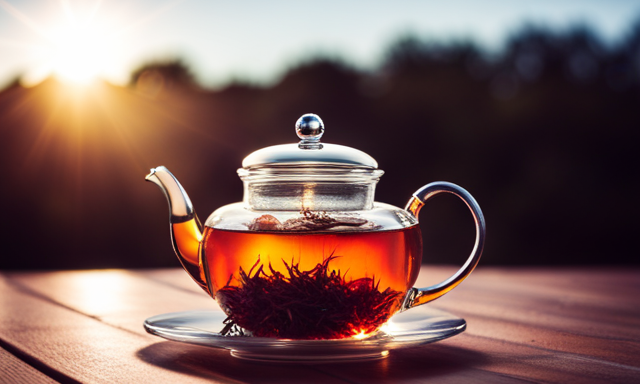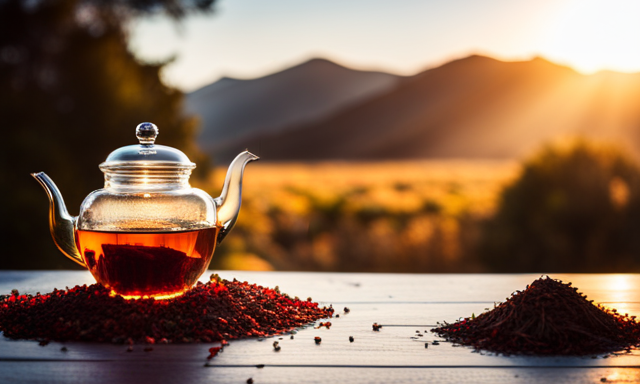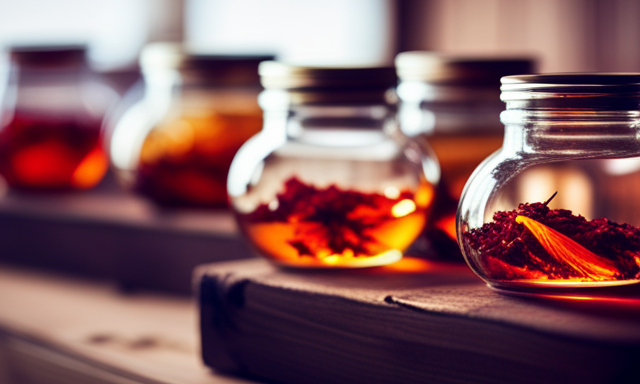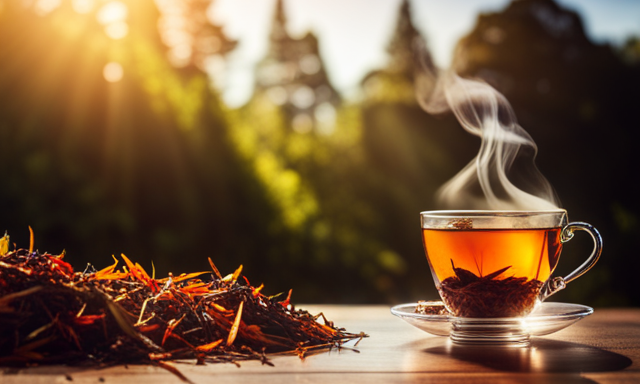As I hold the warm cup of rooibos tea in my hands, I can’t help but feel a sense of comfort and relaxation. The rich aroma wafts through the air, instantly soothing my senses.
Ah, the wonders of a perfectly steeped cup of rooibos tea. If you’re like me, you want to know the secret to achieving that perfect brew every time. Well, look no further, because in this article, I will guide you through the art of steeping rooibos tea to perfection.
From understanding the basics to choosing the right tea leaves, boiling water to the correct temperature, and measuring the proper amount of tea, we will explore it all.
So, join me on this journey as we unlock the secrets to steeping rooibos tea just right. Trust me, your taste buds will thank you.
Key Takeaways
- Steep rooibos tea for 5-7 minutes.
- This allows the flavors to develop fully.
- Following the recommended steeping time is important.
- Enjoy the experience and savor the flavors and warmth.
Understanding the Basics of Rooibos Tea
To understand the basics of rooibos tea, it is essential to know that it is a herbal tea made from the leaves of the Aspalathus linearis plant, native to South Africa. Also known as red bush tea, it is caffeine-free and offers numerous health benefits due to its high antioxidant content and potential immune-boosting properties.
There are two main varieties of rooibos tea: green rooibos, which undergoes minimal oxidation, and red rooibos, which is fully oxidized. Steeping time for rooibos tea varies depending on personal preference, but a good guideline is to steep it for about 5-7 minutes. This duration ensures a perfect cup of rooibos tea.
To enjoy the best flavor and quality, it is important to choose high-quality rooibos tea leaves. Look for leaves that are fresh, fragrant, and vibrant in color. These characteristics indicate that the tea leaves are of superior quality.
Now, let’s move on to the next section, where we will discuss how to choose high-quality rooibos tea leaves.
Choose High-Quality Rooibos Tea Leaves
Looking to enjoy the best cup of rooibos tea? Make sure you choose high-quality tea leaves for a truly satisfying experience. When it comes to rooibos tea, opting for organic varieties is a wise choice.
Organic rooibos is grown without the use of harmful pesticides or chemicals, ensuring a purer and more natural flavor. Additionally, choosing organic rooibos has numerous benefits. It is packed with antioxidants that can boost your immune system and promote overall health. Rooibos tea is also caffeine-free, making it a great alternative to traditional teas for those looking to reduce their caffeine intake.
So, when you’re shopping for rooibos tea, be sure to select organic options to reap the full benefits of this delicious and healthy beverage.
Now, let’s move on to the next step: boiling water to the right temperature.
Boil Water to the Right Temperature
To ensure a delightful cup of rooibos tea, start by boiling water to the perfect temperature. Here are three key steps to follow:
-
Pay attention to the water temperature: Rooibos tea requires water that is not boiling, but rather hot. Aim for a water temperature of around 200°F (93°C). This will allow the tea leaves to release their flavors without becoming bitter.
-
Boil the water for the right amount of time: Bring the water to a rolling boil and then remove it from the heat source. Let it sit for a few seconds to cool slightly before pouring it over the tea leaves. This will prevent scorching and ensure a smooth and flavorful brew.
-
Use a thermometer if needed: If you want to be precise, use a kitchen thermometer to measure the water temperature accurately. This will give you more control over the brewing process and help you achieve the perfect cup every time.
Now that we have the water ready, let’s move on to the next step of measuring the proper amount of rooibos tea.
Measure the Proper Amount of Rooibos Tea
To measure the proper amount of flavorful rooibos tea, start by using a teaspoon. For a standard cup, one teaspoon of rooibos tea is usually enough. If you prefer a stronger flavor, add an extra half teaspoon. Find your personal preference and adjust accordingly. Steeping techniques can vary, but steeping rooibos tea for 5-7 minutes usually provides the optimal balance of flavor and aroma. As the tea steeps, the flavors will develop, creating a delightful experience. Let’s move on to the next step: steeping the tea for the right amount of time.
Steep the Tea for the Right Amount of Time
Finding the perfect balance of flavor and aroma in your cup of rooibos tea is crucial. Steeping the tea for the right amount of time is key to achieving that balance. Rooibos tea is known for its rich flavor and numerous health benefits. Steeping it for too long or too short can affect the taste and potency of the brew.
Generally, steeping rooibos tea for 5-7 minutes is recommended to extract its full flavor and beneficial compounds. However, you can always experiment with different flavors by adjusting the steeping time. Steeping it for a shorter duration may result in a lighter and more delicate taste. On the other hand, a longer steeping time can intensify the flavors.
So, feel free to explore and find your personal preference for the perfect cup of rooibos tea.
Experiment with Steeping Times for Personal Preference
Discovering your personal preference for the perfect cup of rooibos tea involves exploring and experimenting with different steeping times. The experiment duration is crucial in determining the strength and flavor profile of the tea.
Some people prefer a shorter steeping time of around 3-4 minutes for a milder taste, while others may opt for a longer duration of 5-6 minutes for a stronger and more robust flavor. It’s important to keep in mind that steeping too long can result in a bitter taste.
To find your preferred steeping time, start by steeping the tea for the minimum recommended time and gradually increase it until you achieve the desired taste. Once you have determined your preferred steeping time, you can move on to the next step of using a tea infuser or strainer for easy brewing.
Use a Tea Infuser or Strainer for Easy Brewing
To make your brewing process easier, simply use a tea infuser or strainer. This will allow you to effortlessly enjoy the perfect cup of rooibos tea. Tea brewing tips can greatly enhance the taste and quality of your tea.
Using a tea infuser or strainer ensures that you get a clear and smooth cup of rooibos tea, free from any loose leaves or debris. The benefits of using a tea infuser are numerous. It allows the tea leaves to fully expand and release their flavors, resulting in a more flavorful and aromatic brew.
Additionally, the infuser or strainer makes it easy to remove the leaves, preventing over-steeping and bitterness. By using this simple tool, you can savor the full-bodied taste of rooibos tea without any hassle.
Now, let’s move on to the next section about avoiding over-steeping to prevent bitterness.
Avoid Over-Steeping to Prevent Bitterness
To prevent your cup of rooibos tea from becoming bitter, be careful not to let it sit in hot water for too long. Over-steeping rooibos can lead to a bitter flavor that masks its natural sweetness. Follow these tips for achieving optimal flavor:
-
Steep for the recommended time: Rooibos tea generally requires a steeping time of 5 to 7 minutes. Set a timer to ensure you don’t forget about your brew.
-
Use the right water temperature: Boil water and let it cool for a minute or two before pouring it over the tea leaves. The ideal temperature for rooibos is around 212°F (100°C).
-
Don’t squeeze the tea bag: Avoid squeezing or pressing the tea bag against the sides of your cup. This can release unwanted tannins and bitterness.
By following these steps, you can prevent over-steeping and enjoy a delicious cup of rooibos tea. Enhance the flavor with additions like honey or lemon to further elevate your tea-drinking experience.
Enhance the Flavor with Additions like Honey or Lemon
Enhance the flavor of your cup of rooibos tea with additions like honey or lemon, creating a delightful and refreshing tea-drinking experience. Both honey and lemon bring their own unique qualities to the table, allowing you to customize your tea to suit your preferences. Honey adds a natural sweetness to the earthy flavor of rooibos, while lemon provides a tangy and citrusy twist. Additionally, these additions offer their own health benefits. Honey is known for its antibacterial properties and soothing effect on the throat, while lemon is packed with vitamin C, boosting your immune system. Experiment with different combinations to find your perfect blend. In the next section, we will explore other ways to enjoy the perfect cup of rooibos tea, ensuring a truly satisfying tea-drinking experience.
Enjoy the Perfect Cup of Rooibos Tea
Savor the ultimate cup of rooibos tea by discovering new ways to enjoy its rich and invigorating flavors. Here are some tips to help you enjoy the perfect cup of rooibos tea:
-
Experiment with different flavors: Rooibos tea is known for its naturally sweet and nutty flavor, but you can enhance it by adding different flavors like vanilla, cinnamon, or mint. These additions can bring a whole new dimension to your tea experience.
-
Benefits of drinking rooibos tea: Apart from its delicious taste, rooibos tea also offers numerous health benefits. It is rich in antioxidants, helps with digestion, and promotes relaxation. By incorporating rooibos tea into your daily routine, you can enjoy these benefits while indulging in a delightful beverage.
-
Steeping time: To achieve the perfect cup of rooibos tea, steep it for about 5-7 minutes. This will allow the flavors to fully develop, giving you a rich and satisfying taste.
-
Enjoying the experience: Sit back, relax, and savor each sip of your rooibos tea. Take a moment to appreciate the flavors and the warmth it brings. Enjoy the benefits of drinking this wonderful tea while exploring different flavors to suit your preferences.
Frequently Asked Questions
Can I reuse rooibos tea leaves for a second steep?
Sure, you can totally give those rooibos tea leaves another go! Just remember, the steeping time might need to be extended slightly to extract the same level of flavor. Happy sipping!
How long does it take for rooibos tea to cool down after boiling?
It takes about 5-10 minutes for rooibos tea to cool down to the ideal temperature for drinking. The steeping time of rooibos tea can affect its health benefits, with longer steeping times extracting more antioxidants.
Can I use cold water to steep rooibos tea?
Using cold water to steep rooibos tea? Sure, if you want a flavorless drink. The benefits of steeping rooibos tea with hot water include extracting its rich flavors and health-promoting antioxidants.
How does the steeping time affect the flavor of rooibos tea?
Steeping time impacts the flavor of rooibos tea by enhancing its taste profile. The longer the steeping time, the stronger and more robust the flavor becomes. Adjusting the steeping time allows for a customized experience.
Can I drink rooibos tea without adding any sweeteners or flavorings?
To enjoy the health benefits of rooibos tea, I prefer drinking it plain without any sweeteners or flavorings. Rooibos tea has a naturally sweet and earthy taste that doesn’t require any additives.
Conclusion
In the realm of tea steeping, the dance of time is crucial. Just as a skilled dancer knows when to step forward and when to gracefully retreat, the art of steeping rooibos tea requires precision and finesse.
The delicate leaves, infused with warmth, release their essence, creating a symphony of flavors. As the clock ticks, the tea imparts its wisdom, soothing the soul and invigorating the senses.
With each sip, one is transported to a realm of tranquility and bliss. Rooibos tea, a true elixir of life.










